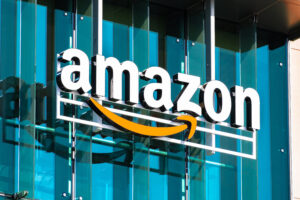
Amazon announced its first loss since 2015 on Thursday as sales slowed, costs rose and its investment in electric vehicle company Rivian wiped out profits.
The news sent Amazon’s shares tumbling by 10% in after hours trading.
The tech giant’s revenues grew at a sluggish 7% in the first quarter to $116.4bn, Amazon’s slowest growth rate in nearly two decades. For the same quarter last year, Amazon’s sales increased 44% to $108.5bn. It lost $3.8bn for the quarter compared with a profit of $8.1bn during the same period a year ago.
The company warned there may be more losses ahead. For the current quarter, Amazon expects operating income between a loss of $1bn and a gain of $3bn, compared with $7.7bn in second quarter of 2021.
Amazon’s stake in electric vehicle company Rivian was largely to blame for the loss. Amazon owns close to 20% of the company and lost $7.6bn after shares in the electric vehicle collapsed, falling by more than 50%.
“The pandemic and subsequent war in Ukraine have brought unusual growth and challenges,” said Andy Jassy, the Amazon chief executive officer.
Brian Olsavsky, Amazon’s chief financial officer, said incremental costs from inflation, warehouse capacity exceeding demands and other issues had cost the company about $6bn over the quarter.
Amazon was one of the biggest winners of the pandemic, recording huge jumps in sales as consumers moved to shopping online and companies turned to Amazon Web Services (AWS), its cloud computing unit, to run their businesses. AWS sales increased 37% over the quarter.
As Covid-19 vaccination rates increase and hospitalizations fall, shoppers are switching back to bricks and mortar. In-store shopping rose 11.2% in March while online fell 3.3%, according to Mastercard SpendingPulse, a monthly transactions report.
Amazon is not the only online retailer feeling the change. The share of retail purchases made online has dropped from 15.7% in the second quarter of 2020 to 12.9% during the last three months of 2021, according to Census Bureau data. But as Mastercard’s survey shows, online retailers gained hugely over the pandemic. E-commerce grew over 83% from March 2019 to March 2022 compared to a 9.4% growth rate for in-store shopping.
The company faces additional pressure from employees across the country who are pushing to unionize and negotiate for higher wages, better working conditions and benefits.
Earlier this month Amazon workers in Staten Island, New York, became the first to vote for a union in the US. Votes to establish a union at a second Amazon facility in New York will be counted on Monday and organizers say they have been inundated with calls from other Amazon outposts to help them set up unions.
“Today, as we’re no longer chasing physical or staffing capacity, our teams are squarely focused on improving productivity and cost efficiencies throughout our fulfillment network. We know how to do this and have done it before. This may take some time, particularly as we work through ongoing inflationary and supply chain pressures, but we see encouraging progress,” said Jassy.
Read more:
Amazon sees first loss since 2015 as shares tumble 10%






